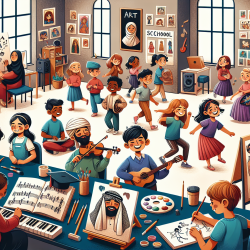In the realm of educational interventions, arts education stands out as a multifaceted approach with the potential to enhance a variety of competencies in children. A systematic review titled "Arts in Education: A Systematic Review of Competency Outcomes in Quasi-Experimental and Experimental Studies" provides valuable insights into the effects of arts education on different competency outcomes.
As a practitioner dedicated to improving children's outcomes, it's essential to leverage the findings of this comprehensive review to refine and enhance your practice. The review examines the impact of school-based arts education across various domains, including music, drama, dance, and visual arts, and categorizes outcomes into broader competency categories using the OECD's Definition and Selection of Competencies (DeSeCo) framework.
Key Findings and Practical Implications
The review highlights several key findings that can inform your practice:
- Music Education: Evidence suggests that music education can enhance arithmetic skills, processing speed, and working memory, particularly in auditory components. However, the effects on vocabulary, visual memory, and non-verbal intelligence are inconsistent. Incorporating music education in your practice can help improve specific cognitive functions in children.
- Drama Education: Drama classes can positively impact verbal intelligence and social competencies such as empathy and prosocial behavior. These outcomes underscore the importance of drama in fostering both cognitive and social skills.
- Dance Education: Dance interventions have been shown to enhance social networks and a sense of belonging, particularly among boys. Dance can be a powerful tool to promote social cohesion and collaboration in your practice.
- Visual Arts Education: Visual arts programs can boost self-efficacy and creativity, particularly in the originality dimension of divergent thinking. Implementing visual arts activities can foster creativity and self-confidence in children.
Methodological Considerations
The review also emphasizes the methodological characteristics and limitations of the included studies. Most studies had small sample sizes, short intervention durations, and limited follow-up periods, which can affect the reliability of the findings. To enhance the rigor of your practice, consider the following recommendations:
- Design longer-term interventions with sufficient follow-up periods to capture meaningful effects.
- Incorporate larger sample sizes to increase the statistical power of your evaluations.
- Combine quantitative and qualitative methods to gain a comprehensive understanding of the outcomes and mechanisms of arts education.
Encouraging Further Research
While the review provides valuable insights, it also highlights the need for further research, particularly in the domains of drama, dance, and visual arts. As a practitioner, you can contribute to this growing body of evidence by conducting well-designed studies and sharing your findings with the broader community.
To read the original research paper, please follow this link: Arts in Education: A Systematic Review of Competency Outcomes in Quasi-Experimental and Experimental Studies.










